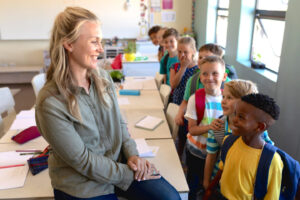Washington schools among those experimenting with year-round school
(The Center Square) – With schools out for the summer, students and staff may not know how many days are left before going back to class. But some schools are looking at a shorter summer break as…

(The Center Square) – With schools out for the summer, students and staff may not know how many days are left before going back to class. But some schools are looking at a shorter summer break as a way to reduce learning losses and balance out the school year.
Advocates say that year-round school, or what is sometimes called a balanced calendar, allows students to retain learning better, catch up if they are struggling and offers the school community well-timed breaks to better recuperate.
David Hornak, executive director of the National Association For Year-Round Education, told Chalkboard that there’s been a renewed interest in the approach that reduced time off in the summer to use the 180 school days more “efficiently.”
But Hornak says the term “year-round” has fallen out of favor because it is a misnomer.
“When people hear ‘year-round education,’ they believe that their kids will attend 300-plus days of school,” Hornak told Chalkboard. “And that’s just not the case.”
Hornak said balanced calendars still offer students and staff a break of six to eight weeks in the summer. They also get a week off in October, a week at Thanksgiving, two weeks around Christmas, a full week in February, a full week at spring break and some time off around Memorial Day before ending in late June.
Hornak said that parents appreciate the shorter summer breaks because they find that their students get bored after about six weeks and that budgeting for childcare is easier.
Preferences for it aside, Hornak said year-round learning is better suited to help students get back on track after pandemic-era school closures than the traditional school calendar. Besides combatting break-related learning loss called the “summer slide,” Hornak contends that some students need 150 school days, some need 180 days and some students need 220 or more days of school.
“Unfortunately, the traditional calendar only allows them 180 days of school,” Hornak said. “Therefore, they continue to fall further behind their counterparts. The balanced calendar provides opportunities for students who need additional instructional days to access those days during a scheduled break in what we call ‘intersession.’”
Hornak said intersessions allow for specific students to have remediation or educational enrichment opportunities during a break.
“On the heels of a pandemic, a balanced calendar allows more opportunities to complete the unfinished learning that may have occurred during online learning,” Hornak said. “We have more kids that need the 220 days than we probably have that only need the 150.”
Hornak said that adding school days is pricey, but keeping only certain, targeted students in classes and paying a few teachers extra to stay over breaks can close learning gaps dramatically.
Balanced calendars aren’t just theoretical. Hornak estimates that 4% of schools, or 2 million students across the nation, use the year-round approach. Hornak is also the superintendent of Holt Public Schools in Holt, Michigan, where two elementary schools use a balanced calendar.
Washington state’s superintendent of public instruction has launched the Balanced Calendar Initiative, offering grants using federal pandemic-relief funds to over 40 school districts to study the balanced calendar to see if the approach is something the districts would like to offer. The initiative has relied on Hornak as a consultant.
Jon Ram Mishra, the state’s assistant superintendent of elementary, early learning and federal programs, said out of those, six schools across Washington are currently on the balanced calendar. All of them have positive things to say about making the switch.
Mishra told Chalkboard those schools are seeing the benefits of the balanced approach come to fruition in its second year, with a massive effect on the well-being of school staff. That said, Mishra attributes the success of the new calendar system to everyone working together.
“The success of this initiative has been because we’ve engaged with a lot of education partners in our state,” Mishra said. “We have hubs that help support the work. When we start talking about student success, everyone comes together. When issues come up, we deal with them.”
One of those issues was sports, which required conversations at the state level about how to handle the different calendars. But Mishra said the state’s student-athletes compete over the winter break anyway, and the state doesn’t have a standard spring break.
Another issue is funding, but Katy Payne, executive director of communications for Washington’s superintendent’s office, said it’s been interesting to see how Winlock School District has braided its income streams to support its balanced calendar, using different buckets of money to complement the grant program’s federal Elementary and Secondary School Emergency Relief Funds.
With the national conversation around combatting learning loss and the successes reported by school districts that have made the switch, Hornak says now is the time to consider year-round education alternatives to what most people experienced.
“It’s time for educational leaders to give the balanced calendar a look,” Hornak said. “I’ve yet to meet a balanced-calendar educator who has elected to leave the balanced calendar to return to the traditional calendar. Once you live it, you love it.”



